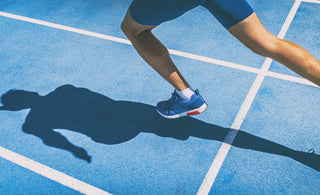
Think back to the day your first picked up running. Maybe it was last week, years or decades ago. Your first run was likely your hardest as you tried to find your footing and a pace you could stick to. Fast forward to today and you are faster and stronger than ever, but you’ve hit a plateau. Are your running times the same? Are you getting bored running the same loop every week? In today’s blog, we are going to share some of our favourite exercises and tips for helping you bust through your running plateaus and hit new personal records in both times and distances! Ready, set , run!
Running Specific Exercises:
Exercise #1: Speed Work
In order to run faster, you need to get a taste of what it feels like to run at a faster pace. If you’re new to running, this can be accomplished by setting a tabata timer on your phone for 30 seconds of work, followed by 30 seconds of rest. This 1:1 ratio gives you a 30 second window to challenge yourself to run at a faster speed knowing that you can fall back into a slower recovery pace shortly after. These running windows also help to develop strength in your quadricep and hip flexors muscles, the two major muscle groups you are calling upon during your runs.
Exercise #2: Hill Training
If reading those two words together made you scrunch your face up like you just ate a slice of lemon, you likely need it more than you’re willing to admit. Similar to speed work, hill training requires an increased amount of strength and as a result, helps you build it. Increasing the incline of your hills forces you to control your breathing and to establish a pace that you can maintain throughout the duration of the climb. After running hills, flat terrain will feel like a breeze and you’ll be flying down the streets thanks to your newly developed legs!
Exercise #3: Stretch
Most athletes assume that in order to improve in their sport, they need to train harder, longer and be more displiced. That is true to an extent as the more your practice, the better conditioned you will be as a result. But the exercise that most athletes overlook is stretching! Regular stretching improves your flexibility, range of motion, posture and can improve blood flow. You might be thinking, “that’s great, but how does that help me run faster?” Great question. Take your stride length for example. Let’s say that your stride length is 50 centimeters. You work a 9-5 job that requires you to sit and your hip flexors are tight as a result. Stretching helps to re-lengthen those muscles, allowing for a greater range of motion, recoil and elasticity. This can increase the length of your stride allowing you to run further distances while exerting less energy simply by doing a few hip stretches!
Exercises #4: Sleep
Yes, you read that right, sleep. This point ties in with the last. Most runners believe they have to train more in order to improve their performance. But what if they are the one’s standing in the way of new personal records because they are overtraining and not allowing their bodies to recover enough? When you’re running, your muscles are physically breaking down on a cellular level. Sleeping on the other hand, allows our body to repair tissue, build muscle and increases our metabolism. A hormone called, “human growth hormone” is released when we sleep and increases the speed at which athletes recover from their workouts. It should be obvious that the less sleep that we obtain, the longer it takes our bodies to feel ready and primed to be pushed again. Have we convinced you to try to sleep for longer periods of time? Great! Start by maintaining a consistent sleep schedule, avoiding heavy meals and liquids within 3 hours before bed, turning off your electronics and sleeping in a cool, quiet and dark room. Soon you’ll get excited to go to bed as you will experience the physical and mental benefits that more sleep has to offer!
Exercise #5: Strength Training
If you want to get stronger, strength training needs to be a priority! Strength training strengthens muscles and joints which can improve race times, decrease injury risk and allow you to run further distances while expending less energy. Some of the best strength training exercises for runners include squats, lunges, lateral lunges and deadlifts. These exercises help to strengthen the quads, glutes, hamstrings and calves, all of which are important muscle groups that are called upon when running. Adding resistance work for the hip flexors by attaching a band to a rig or post, lie flat on your back in front of it with your foot in the loop and draw your knee to your chest. This is a phenomenal exercise to strengthen your hip flexors, the most heavily taxed muscle in running!
If you’re really serious about taking your running game to the next level, find yourself a running partner. Preferably someone that is stronger, faster and more experienced than you. This will allow you to run longer distances at a faster speed, all whilst learning from the best! Besides, a little running competition never hurt anyone - we can almost guarantee that you’ll run faster with a partner than solo when there’s someone else pushing the pace!
-By Lindsay Mustard. Lindsay is a Holistic Nutritionist, firefighter-in-training and recipe-wizard with a burning passion for health and fitness. In her nutrition practice, Lindsay works with clients to craft a unique plan that is tailored to their specific health goals using a natural, whole food and supplement approach.

